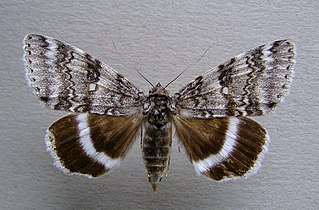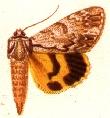
Catocala is a generally Holarctic genus of moths in the family Erebidae. The genus was erected by Franz von Paula Schrank in 1802. The moths are commonly known as underwing moths or simply underwings. These terms are sometimes used for a few related moths, but usually – especially when used in plural, not as part of a species name – they are used to refer to Catocala only.

Catocala briseis, the Briseis underwing or ribbed underwing, is a moth of the family Erebidae. The species was first described by William Henry Edwards in 1864. It is found across the North American Boreal forest region from Newfoundland to the Pacific, south to Massachusetts and Pennsylvania.

Catocala californica is a moth of the family Erebidae first described by William Henry Edwards in 1864. It is found in western North America from British Columbia and Alberta south through Washington and Oregon to California.

Catocala hermia, the Hermia underwing, is a moth of the family Erebidae. The species was first described by Henry Edwards in 1880. It is found throughout the Great Plains of North America, from southern Saskatchewan and Alberta south and west to Texas, Arizona and California.

Catocala junctura, the joined underwing or Stretch's underwing, is a moth in the family Erebidae. The species was first described by Francis Walker in 1858. It is found throughout temperate North America, ranging from New York and Pennsylvania west to Montana, Colorado, Oklahoma, Arizona, and into Texas, and north to southern Illinois, extreme southern Alberta and Saskatchewan; it has also been recorded west of the Rocky Mountains from California and south-eastern British Columbia. It is typically found near water, where the food plants of its caterpillar larvae grow plentifully.

Catocala relicta, the white underwing or relict, is a moth of the family Erebidae. The species was first described by Francis Walker in 1858. It lives in southern Canada, from Newfoundland to Vancouver Island, south to Missouri, and Arizona.

Catocala chelidonia is a moth of the family Erebidae. It is found from Arizona and Utah to California.

Catocala desdemona, the Desdemona underwing, is a moth of the family Erebidae. The species was first described by Henry Edwards in 1882. It is found in Utah and Arizona, ranging south into New Mexico and Texas, and onwards through Mexico up to Honduras.

Catocala gracilis, the graceful underwing, is a moth of the family Erebidae. The species was first described by William Henry Edwards in 1864. It is found in North America from Manitoba to Nova Scotia and Maine, south through Connecticut, New Jersey to Florida and west to Mississippi and Missouri.

Catocala herodias, the Herodias underwing or Gerhard's underwing, is a moth of the family Erebidae. The species was first described by Strecker in 1876. The nominate form is found in the US states of Texas and Oklahoma. Subspecies Catocala herodias gerhardi is found from Massachusetts, Connecticut, New York to Virginia. The gerhardi subspecies is listed as endangered in Connecticut.

Catocala ophelia is a moth of the family Erebidae. It is found in the dry forests of Arizona, California and south-western Oregon.

Catocala verrilliana, or Verrill's underwing, is a moth of the family Erebidae. The species was first described by Augustus Radcliffe Grote in 1875. It is found in the US from Washington and Oregon to Colorado and south to California, Arizona and Texas, and Cimarron County in western Oklahoma.

Catocala violenta is a moth of the family Erebidae. It is found from Colorado to Arizona, east to Texas and into Mexico.

Catocala benjamini, or Benjamin's underwing, is a moth of the family Erebidae. The species was first described by Auburn Edmund Brower in 1937. It is found in the US states of Arizona, Nevada, southern California and southern Utah.

Catocala micronympha, the little nymph underwing or little bride underwing, is a moth of the family Erebidae. The species was first described by Achille Guenée in 1852. It is found in North America from southern Ontario, Quebec, and Manitoba through New Hampshire, Connecticut, and New Jersey to Florida, west to Texas and then north through Oklahoma, Kansas, Iowa, to Wisconsin and Minnesota and then east to Michigan.

Catocala similis, the similar underwing, is a moth of the family Erebidae. The species was first described by William Henry Edwards in 1864. It is found in North America from Ontario and Quebec south through Maine and Connecticut to Florida, west to Texas and Oklahoma, and north to Minnesota.

Catocala californiensis is a moth of the family Erebidae. It is found in southern California.

Catocala jessica, the Jessica underwing, is a moth of the family Erebidae. The species was first described by Henry Edwards in 1877. It was described in the United States from Arizona through Colorado to Illinois and California.

Catocala mcdunnoughi, or McDunnough's underwing, is a moth of the family Erebidae. The species was first described by Auburn Edmund Brower in 1937. It is found in the US state of California.

Catocala messalina, the Messalina underwing, is a moth of the family Erebidae. The species was first described by Achille Guenée in 1852. It is found in the United States from Virginia south to Florida and west to Texas and north to Kansas.













